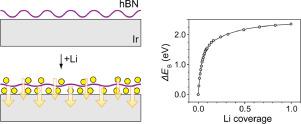当前位置:
X-MOL 学术
›
Surf. Sci.
›
论文详情
Our official English website, www.x-mol.net, welcomes your
feedback! (Note: you will need to create a separate account there.)
Sequential lithium deposition on hexagonal boron nitride monolayer on Ir(111): Identifying intercalation and adsorption
Surface Science ( IF 2.1 ) Pub Date : 2021-04-01 , DOI: 10.1016/j.susc.2020.121786 Marin Petrović
Surface Science ( IF 2.1 ) Pub Date : 2021-04-01 , DOI: 10.1016/j.susc.2020.121786 Marin Petrović

|
Stepwise deposition of Li atoms onto hexagonal boron nitride (hBN) monolayer on Ir(111) is investigated by means of angle-resolved photoemission spectroscopy and low-energy electron diffraction. Sequential Li deposition progressively shifts the band structure of hBN to higher binding energies due to the induction of a variable electric potential originating from electronic charge donation by alkali atoms. At small coverages, Li atoms preferably intercalate under the hBN layer, where they are highly charged and give rise to a large initial shift of the band structure. Additionally, intercalated Li atoms effectively decouple hBN from the substrate and consequently reduce its moir\'e corrugation. As the deposition progresses further, Li atoms also adsorb on top of hBN, and the average effective charge of both intercalated and adsorbed Li atoms progressively diminishes due to the Coulomb repulsion penalty, which is partially screened by the metal substrate in the intercalated subsystem. This gives rise to a saturation of the respective electric potential and the band structure shift, and elaborates on the pathways and limitations of chemical functionalization of epitaxial hBN systems with charge donating species.
中文翻译:

在 Ir(111) 上六方氮化硼单层上的连续锂沉积:识别嵌入和吸附
通过角分辨光电子能谱和低能电子衍射研究了锂原子在 Ir(111) 上的六方氮化硼 (hBN) 单层上的逐步沉积。由于碱原子提供的电子电荷引起的可变电势的感应,连续的锂沉积逐渐将 hBN 的能带结构转移到更高的结合能。在小覆盖率下,锂原子优选嵌入 hBN 层下方,在那里它们高度充电并引起能带结构的大初始位移。此外,嵌入的锂原子有效地将 hBN 与基板分离,从而减少了其莫尔波纹。随着沉积的进一步进行,锂原子也吸附在 hBN 的顶部,由于库仑排斥惩罚,嵌入和吸附的锂原子的平均有效电荷逐渐减少,这部分被嵌入子系统中的金属基底屏蔽。这导致相应电位的饱和和能带结构偏移,并详细阐述了具有电荷供体物质的外延 hBN 系统化学功能化的途径和局限性。
更新日期:2021-04-01
中文翻译:

在 Ir(111) 上六方氮化硼单层上的连续锂沉积:识别嵌入和吸附
通过角分辨光电子能谱和低能电子衍射研究了锂原子在 Ir(111) 上的六方氮化硼 (hBN) 单层上的逐步沉积。由于碱原子提供的电子电荷引起的可变电势的感应,连续的锂沉积逐渐将 hBN 的能带结构转移到更高的结合能。在小覆盖率下,锂原子优选嵌入 hBN 层下方,在那里它们高度充电并引起能带结构的大初始位移。此外,嵌入的锂原子有效地将 hBN 与基板分离,从而减少了其莫尔波纹。随着沉积的进一步进行,锂原子也吸附在 hBN 的顶部,由于库仑排斥惩罚,嵌入和吸附的锂原子的平均有效电荷逐渐减少,这部分被嵌入子系统中的金属基底屏蔽。这导致相应电位的饱和和能带结构偏移,并详细阐述了具有电荷供体物质的外延 hBN 系统化学功能化的途径和局限性。











































 京公网安备 11010802027423号
京公网安备 11010802027423号